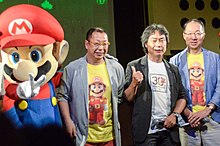Shigeru Miyamoto
Nintendo president Hiroshi Yamauchi decided to convert unsold Radar Scope units into a new arcade game.
[15]: 36 Miyamoto had high hopes for his new project, but lacked the technical skills to program it himself; instead, he conceived the game's concepts, then consulted technicians on whether they were possible.
[19] Miyamoto felt that New York City provided the best setting for the game, with its "labyrinthine subterranean network of sewage pipes".
[21] As Nintendo released its first home video game console, the Family Computer (rereleased in North America as the Nintendo Entertainment System), Miyamoto made two of the most popular titles for the console and in the history of video games as a whole: Super Mario Bros. (a sequel to Mario Bros.) and The Legend of Zelda (an entirely original title).
[6] Super Mario Bros. largely took a linear approach, with the player traversing the stage by running, jumping, and dodging or defeating enemies.
[26] By contrast, Miyamoto employed nonlinear gameplay in The Legend of Zelda, forcing the player to think their way through riddles and puzzles.
"[3] With The Legend of Zelda, Miyamoto sought to make an in-game world that players would identify with, a "miniature garden that they can put inside their drawer.
"[14]: 51 He recreated his memories of becoming lost amid the maze of sliding doors in his family home in Zelda's labyrinthine dungeons.
The Adventure of Link features side-scrolling areas within a larger world map rather than the bird's eye view of the previous title.
[33][34] Bowser's children were designed to be unique in appearance and personality; Miyamoto based the characters on seven of his programmers as a tribute to their work on the game.
Moving the on-screen character to a certain tile will allow access to that level's playfield, a linear stage populated with obstacles and enemies.
[36][37] Using this new hardware, Miyamoto and Katsuya Eguchi designed the Star Fox game with an early implementation of three-dimensional graphics.
Miyamoto and the other designers were initially unsure of which direction the game should take, and spent months to select an appropriate camera view and layout.
[45] The original concept involved a fixed path much like an isometric-type game, before the choice was made to settle on a free-roaming 3D design.
[45] Using what he had learned about the Nintendo 64 from developing Super Mario 64 and Star Fox 64,[9] Miyamoto produced his next game, The Legend of Zelda: Ocarina of Time, leading a team of several directors.
However, when things progressed slower than expected, Miyamoto returned to the development team with a more central role assisted in public by interpreter Bill Trinen.
By reusing the game engine and graphics from Ocarina of Time, a smaller team required only 18 months to finish Majora's Mask.
The game was first revealed at Nintendo Space World 2000 as a technical demo designed to show off the graphical capabilities of the GameCube.
He also produced the 3D game series Metroid Prime, after the original designer Yokoi, a friend and mentor of Miyamoto's, died.
[3] At E3 2004, Miyamoto unveiled The Legend of Zelda: Twilight Princess, appearing dressed as the protagonist Link with a sword and shield.
Following the death of Nintendo president Satoru Iwata in July 2015, Miyamoto was appointed as an acting Representative Director, alongside Genyo Takeda.
He was also appointed the position of "Creative Fellow" at the same time, providing expert advice to Kimishima as a "support network" alongside Takeda.
In a 1992 interview, he said "the important thing is that it feels good when you're playing it" and "that quality is not determined by the story, but by the controls, the sound, and the rhythm and pacing".
We opted not to use that limited time and energy on pre-rendered images for use in cinema scenes, but rather on tests on other inter-active elements and polishing up the game".
[83] Miyamoto's best known and most influential game, Super Mario Bros., "depending on your point of view, created an industry or resuscitated a comatose one".
[86] At the time of the release of Star Fox, the use of filled, three-dimensional polygons in a console game was very unusual, apart from a handful of earlier titles.
[93][94][95][96] Ocarina of Time was listed by Guinness World Records as the highest-rated video game in history, citing its Metacritic score of 99 out of 100.
Levi Buchanan of IGN considered Super Mario Bros. 3's appearance in the film The Wizard as a show-stealing element, and referred to the movie as a "90-minute commercial" for the game.
In the PAL region, which covers most of Asia, Africa, South America, Australia, New Zealand, and most of Western Europe, Twilight Princess is the bestselling Zelda game ever.
She first uttered the phrase at GDC in 1996, or something close to it, “a game’s only late until it ships, but it sucks forever.” It somehow was misconstrued as a Miyamoto quote, circulating on the Internet for many years.




